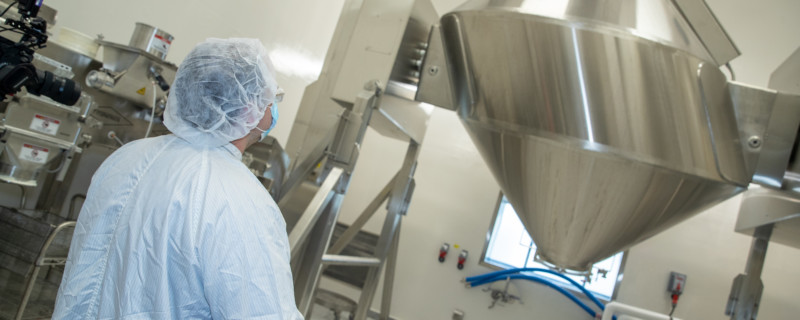
Consistency is key: Optimizing cell culture media manufacturing
Cell culture media play a pivotal role in the biopharmaceutical sector—providing the optimal cellular environments required to produce life-saving biologics. However, reliably sourcing media that are both high-quality and consistent can often present a major challenge for manufacturers.
The raw materials used to manufacture cell culture media formulations are often sourced from different suppliers around the world. Impurities in any one of these raw materials can result in final formulations that vary in content and quality between batches. This variability can be a major hurdle for manufacturers who rely on consistent media to produce safe and efficacious biopharmaceuticals.
Additionally, despite the improved supply assurance that working with a media manufacturer with multiple sites can provide, ensuring the media produced at each site are equivalent is another challenge. This requires that in addition to raw materials, process procedures, manufacturing equipment, and quality management systems including quality control tests, be equivalent.
Therefore, to maintain media consistency, it is key to choose a manufacturer that has established processes for both raw material sourcing and maintaining site-to-site equivalency.
The problem of too many metals
One key cause of media variability is the presence of trace elements found as impurities in certain types of raw materials. Heavy metals, such as copper and manganese, can find their way into media as impurities in key components such as amino acids.
Although manufacturers often choose to add small quantities of trace elements to supplement their media formulations to support cell metabolism and help achieve target yields, unexpected levels of some elements can have major impacts. For example, if there is too much manganese present in a formulation, it can alter glycosylation patterns and protein quality attributes. Excess aluminum and cobalt can lead to greater production of reactive oxygen species that can cause apoptosis, the process of programmed cell death. Above all, utilizing a medium that has variable quantities of trace elements can result in batch-to-batch product inconsistency, which can make a process less sustainable in the long term.
So to avoid these issues and maintain consistency, it is important to understand which raw materials pose the highest risks of introducing elemental impurities into the medium. For instance, research has shown iron salts in particular pose a risk of containing a range of elemental impurities [1]. It is also important to consider cumulative levels of specific elemental impurities that may be present in multiple raw materials. Through this understanding, manufacturers can optimize their sourcing and analytical processes for these high-risk components.
Other causes of variability
Along with elemental impurities, there are several other potential sources of raw material contamination. One such example is contamination of animal origin–free (AOF) components with animal origin (AO) material. This can be a significant issue as, due to being chemically undefined, AO components can be more variable than their AOF counterparts. AO components, such as fetal bovine serum, also require more stringent analysis to verify their safety before they can be used in commercial manufacturing. Consequently, avoiding this type of contamination is essential to both maintaining consistency and protecting patient safety.
Variability can also be introduced through the manufacturing process itself. For instance, utilizing different milling and blending equipment should be reviewed and assessed to confirm equivalency. This can be done by analyzing media attributes and maintaining a validated state. Moreover, differences in facility monitoring systems, and product quality criteria such as performance, can also reveal if there are consistencies.
Reducing variability through analytics
Central to minimizing the risk of media variability are robust procedures for raw material sourcing and qualification, particularly for high-risk components. Raw materials should only be sourced from established markets and meet the required AOF and antibiotic-free standards.
Approved raw material vendors must undergo strict qualification processes that involve batch testing and surveillance audits. These batch tests require state-of-the-art instrumentation with high sensitivities; trace elements are so named for a reason, and therefore a facility’s testing equipment should be able to detect the metals at trace levels.
Equipment together with the associated methods and specifications required for such tests must be uniform across a cell culture media manufacturer’s locations too. To aid the quality control teams that carry out such internal tests, a site’s raw material sourcing inventory should be connected to quality-inputting software so that out-of-specification information can be flagged and the appropriate action taken.
In addition to raw material analysis, a range of other parameters should be assessed. This should include globally harmonized testing for finished formulation attributes such as pH, osmolality, stability, and the level or absence of microbial contamination.
Achieving manufacturing equivalency
Alongside raw material and finished product quality testing, establishing equivalency between the manufacturing processes used at each site within the vendor’s network is also critical to maintain consistency.
Facility audits should ensure that manufacturing sites use comparable equipment and operating systems; one software should ideally unite all machines and processes. Other considerations that can further maintain equivalency include harmonized procedures and staff training processes throughout the network and identical finished product packaging.
There are also several architectural considerations that can reduce the risk of cross-contamination between AO and AOF components. For example, facilities should have a strategic layout of cleanrooms and a unidirectional flow throughout the building that minimizes the risk of contamination from staff. Dedicated sampling booths and gowning/de-gowning airlocks can also help to reduce this risk along with segregation of raw materials.
Choosing a media manufacturer
There are several different factors that developers should consider when choosing a media manufacturing supplier. When it comes to maintaining consistency, the most important are related to supply assurance and equivalency.
One key consideration is whether the manufacturer can offer global manufacturing redundancy. This business continuity factor enables increased productivity capabilities and flexibility in response to changing global supply demands. The importance of this has only been amplified by the recent unprecedented demand for key bioproduction materials.
Similarly, secondary and even tertiary raw material sourcing pathways are good quality indicators for a reliable, reactive media manufacturing vendor. The number of audits the cell culture media manufacturer submits itself to can also be a good indicator. Some of the best global facilities receive over 200 audits each year to confirm their levels of compliance and control over their supply. Equally important, drug/pharmaceutical manufacturers should prioritize choosing a vendor with a detailed equivalency strategy, so they can be confident that their media is consistent regardless of its manufacturing site.
To help reduce the risk of costly delays, biopharmaceutical manufacturers need to take a proactive approach to strengthening their supply chains. However, this should not be done at the expense of maintaining manufacturing consistency. By choosing a vendor with robust supply chains and full, global facility harmonization, manufacturers can be assured of media consistency, in terms of both quality and delivery.
Learn more at thermofisher.com/media-
About the Author
 Michelle Ferreri, Director, Custom Products, Thermo Fisher Scientific Biologicals and Chemicals Division
Michelle Ferreri, Director, Custom Products, Thermo Fisher Scientific Biologicals and Chemicals Division
Michelle Ferreri has more than two decades of experience in the bioprocessing field with a focus on custom cell culture products, customer experience, and technical engagement.